aTriple inhaled therapy, or double inhaled therapy if ICS is inappropriate1

TARGET TYPE 2 INFLAMMATION

REDUCE EXACERBATIONS

IMPROVE HOW PATIENTS BREATHE AND FEEL
Indication
Dupixent is indicated as an add-on maintenance treatment in adult patients with uncontrolled chronic obstructive pulmonary disease (COPD) associated with type 2 inflammation.
For additional information, please click here for the SmPC.
DUPIXENT IS THE FIRST AND ONLY BIOLOGIC TO TARGET TYPE 2 INFLAMMATION IN COPD1
IL-4 and IL-13 are key and central cytokines of type 2 inflammation2
.png)
IL-4 perpetuates underlying type 2 inflammation by differentiating Th0 into Th2.3
Local Inflammation3-6
- Mucus hypersecretion
- Airway remodeling
- Airway smooth muscle hypertrophy
- Epithelial barrier dysfunction
- Parenchymal destruction
.png)
IL-13 promotes goblet cell hyperplasia and mucus hypersecretion.3
Systemic Inflammation3
- Eosinophil trafficking
- B cell class switching
- Mast cell degranulation
- Dyspnea
- Cough
- Sputum production
DUPIXENT, through dual inhibition of IL-4 and IL-13, when used in combination with optimized inhaled therapy,a demonstrated an improvement in symptoms.1,8
aTriple inhaled therapy, or double inhaled therapy if ICS was not appropriate.1
Patient profile is hypothetical and is not an actual patient.
Your patient may be a good candidate for DUPIXENT1,7-9
Type 2 inflammation: Raised blood EOS levels (≥300 cells/µL)
Symptomatic while on optimized inhaled therapya: Breathlessness, cough, and mucus
Exacerbations: Experienced moderate exacerbations or at least 1 severe exacerbation in previous year
a Triple inhaled therapy, or double inhaled therapy if ICS is not appropriate.1
.png)
An elevated blood EOS level is recognized by the 2024 GOLD Report as a clinically useful biomarker in identifying COPD with type 2 inflammation.9
Ahmed

Ahmed’s clinical history
Age 55
Patient profile is representative and is not an actual patient.
|
“It’s hard to make it through a workday. I have to sit down and rest before I can finish my daily work. And coughing up so much mucus is tough. I want to work until I’m 60 and enjoy retirement with my family, but I’m not sure my COPD will allow that.” |
-
On optimized inhaled therapy (ICS, LAMA, LABA; 1 dose per day)
-
Evidence of type 2 inflammation1,7: raised blood EOS levels (310 cells/μL)
-
2 moderate exacerbations requiring treatment with OCS in the past year
-
Quit smoking at age 43, 15 pack-year history
-
4 years since COPD diagnosis
-
FVC: 2.7 L; FEV1/FVC: 0.67; post-BD FEV1: 1.8 L (65% predicted)
.png)
Treatment goal:
Improve breathing, reduce mucus, enjoy quality time with family
Treatment challenge:
Felix remains symptomatic despite being on optimized inhaled therapy for 14 months.
Discover what DUPIXENT can do for patients like Ahmed
Fatima

Fatima’s clinical history
Age 65
Patient profile is representative and is not an actual patient.
|
“I was in the ICU earlier this year. I used to get out to run errands, but now I’m chained to oxygen at home. I can barely get out of my bed. I’m scared that if I go back into the hospital, I might not come home again.” |
-
On optimized inhaled therapy (LAMA, LABA; 1 dose per day)
-
Evidence of type 2 inflammation1,7: raised blood EOS levels (480 cells/μL)
-
1 severe exacerbation requiring hospitalization in the past year
-
Quit smoking at age 73, 35 pack-year history
-
2 years since COPD diagnosis
-
FVC: 2.5 L; FEV1/FVC: 0.52; post-BD FEV1: 1.3 L (48% predicted)
.png)
Treatment goal:
Reduce exacerbation risk, improve quality of life, celebrate simple moments
Treatment challenge:
Rita recently quit smoking after several attempts, but her exacerbations have been severe. With each exacerbation increasing the risk of more, the situation is urgent.10
Discover what DUPIXENT can do for patients like Fatima
Efficacy Exacerbations
DUPIXENT SIGNIFICANTLY REDUCED EXACERBATIONS1
Moderate or severe exacerbations are a major contributor to poor outcomes in COPD8
Exacerbation rate reduction
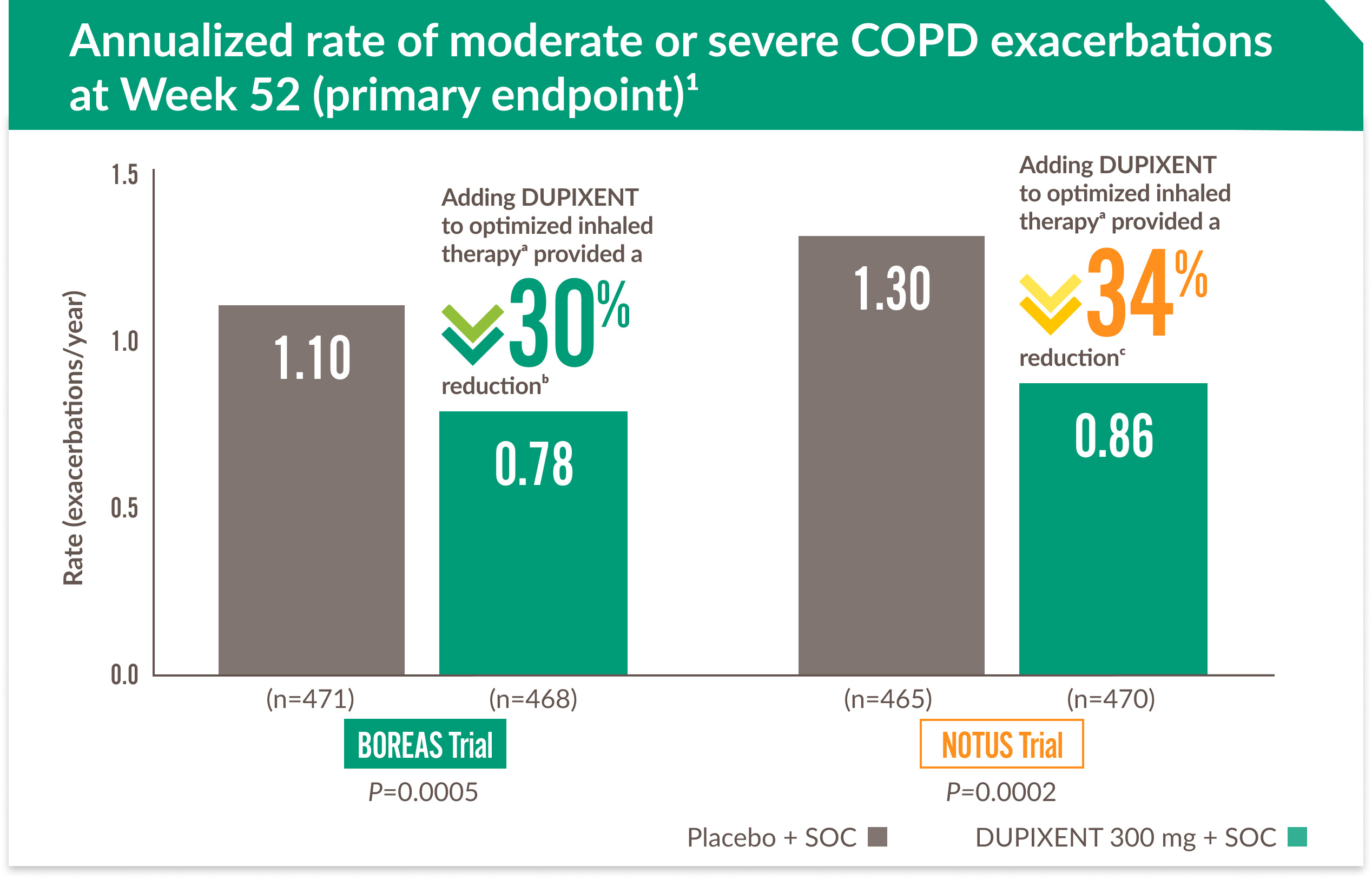
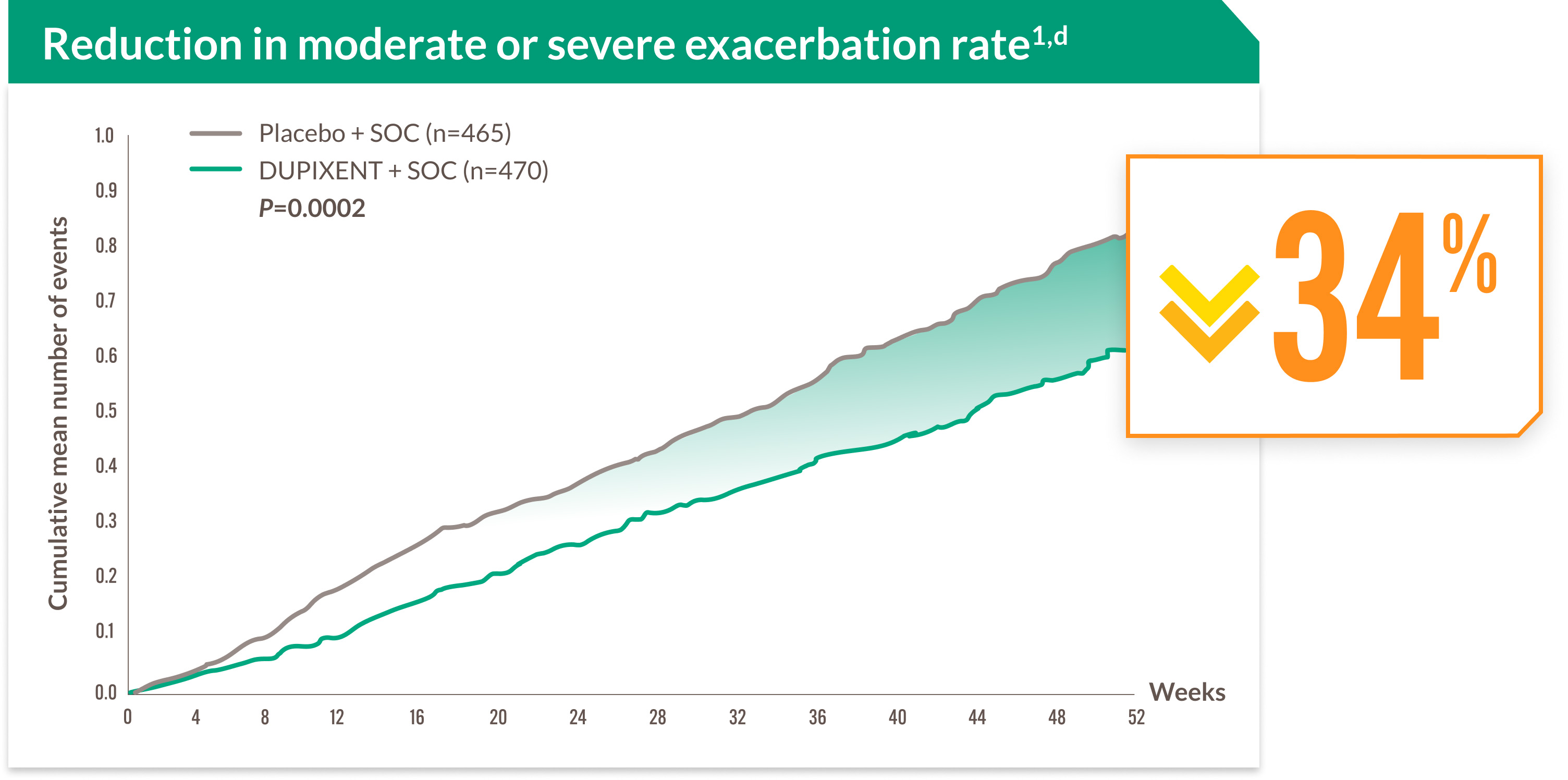
Adding DUPIXENT to optimized inhaled therapya provided a reduction in moderate or severe exacerbations1
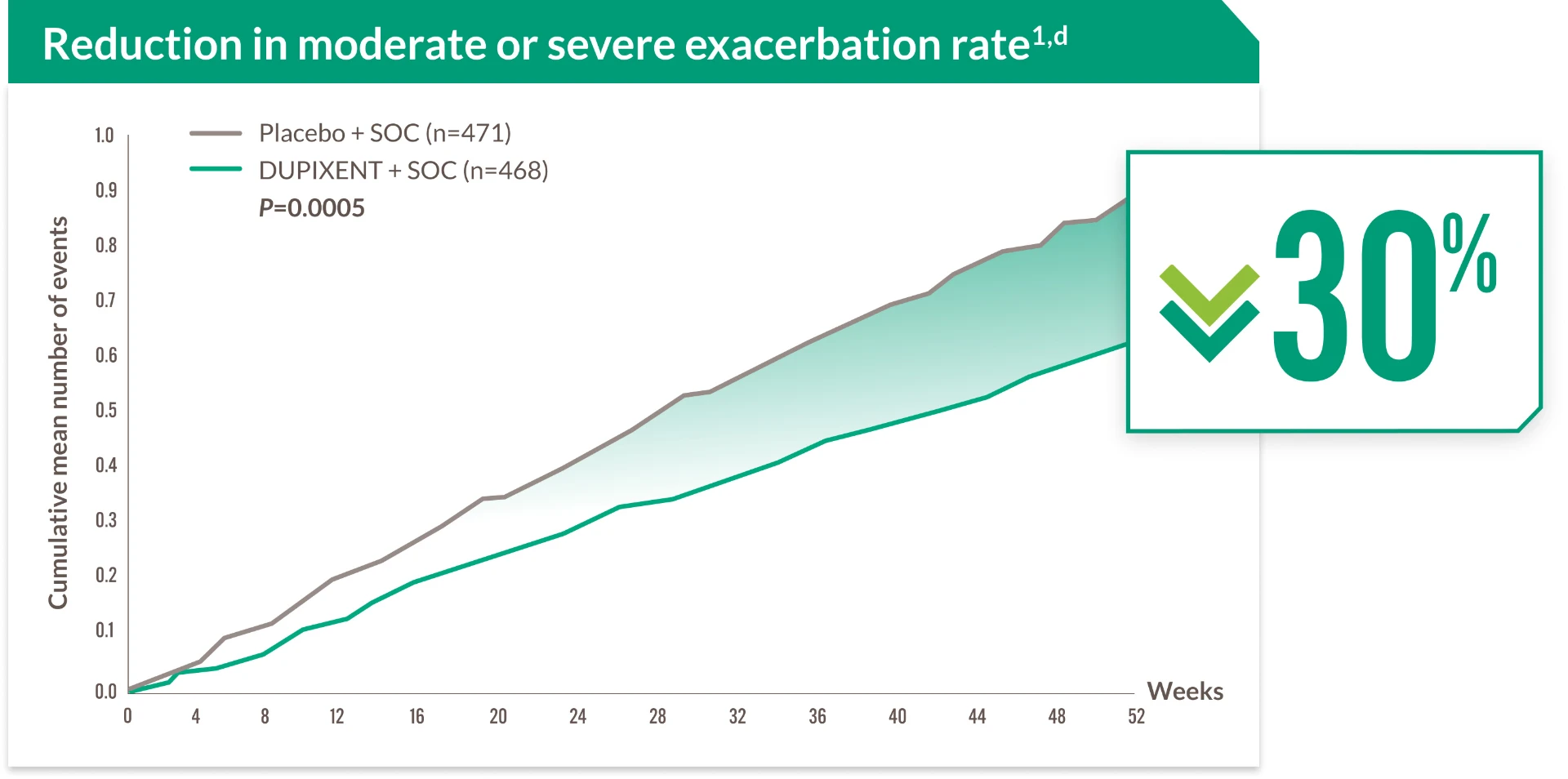
Adding DUPIXENT to optimized inhaled therapya provided a reduction in moderate or severe exacerbations1
Number of moderate or severe exacerbations in prior year
(≤2, n=371 [BOREAS] and n=381 [NOTUS]; 3, n=57 [BOREAS] and n=57 [NOTUS]; ≥4, n=40 [BOREAS] and n=32 [NOTUS])e
Disease severity at baseline
(post-BD FEV1 % predicted: <50%, n=227 [BOREAS] and n=250 [NOTUS] or ≥50%, n=241 [BOREAS] and n=217 [NOTUS])
Smoking status at screening
(former, n=334 [BOREAS] and n=328 [NOTUS]; current, n=134 [BOREAS] and n=142 [NOTUS])
Moderate exacerbations were defined as exacerbations that resulted in treatment with systemic corticosteroids, antibiotics, or both.1
Severe exacerbations were defined as exacerbations that resulted in hospitalization or observation for over 24 hours in an emergency department or urgent care facility.1
a Triple inhaled therapy, or double inhaled therapy if ICS was not appropriate.1
b Rate ratio vs placebo: 0.71 (95% CI: 0.58, 0.86). 1
c Rate ratio vs placebo: 0.66 (95% CI: 0.54, 0.82).1
d The primary endpoint was the annualized rate of moderate or severe exacerbations.1
e Inclusion criteria required patients to have experienced ≥1 exacerbation while on SOC. 8,9

Adding DUPIXENT to optimized inhaled therapya provided a reduction in moderate or severe exacerbations1

Adding DUPIXENT to optimized inhaled therapya provided a reduction in moderate or severe exacerbations1
Number of moderate or severe exacerbations in prior year
(≤2, n=371 [BOREAS] and n=381 [NOTUS]; 3, n=57 [BOREAS] and n=57 [NOTUS]; ≥4, n=40 [BOREAS] and n=32 [NOTUS])e
Disease severity at baseline
(post-BD FEV1 % predicted: <50%, n=227 [BOREAS] and n=250 [NOTUS] or ≥50%, n=241 [BOREAS] and n=217 [NOTUS])
Smoking status at screening
(former, n=334 [BOREAS] and n=328 [NOTUS]; current, n=134 [BOREAS] and n=142 [NOTUS])
Moderate exacerbations were defined as exacerbations that resulted in treatment with systemic corticosteroids, antibiotics, or both.1
Severe exacerbations were defined as exacerbations that resulted in hospitalization or observation for over 24 hours in an emergency department or urgent care facility.1
a Triple inhaled therapy, or double inhaled therapy if ICS was not appropriate.1
b Rate ratio vs placebo: 0.71 (95% CI: 0.58, 0.86). 1
c Rate ratio vs placebo: 0.66 (95% CI: 0.54, 0.82).1
d The primary endpoint was the annualized rate of moderate or severe exacerbations.1
e Inclusion criteria required patients to have experienced ≥1 exacerbation while on SOC. 8,9

MORE CAN I moments with improved breathing
Efficacy Lung Function
Dupixent provided rapid and sustained improvement in patient's breathing
Lung function improved as early as Week 2, sustained through Week 52
BOREAS Trial
Rapid and sustained improvement in lung function1,b
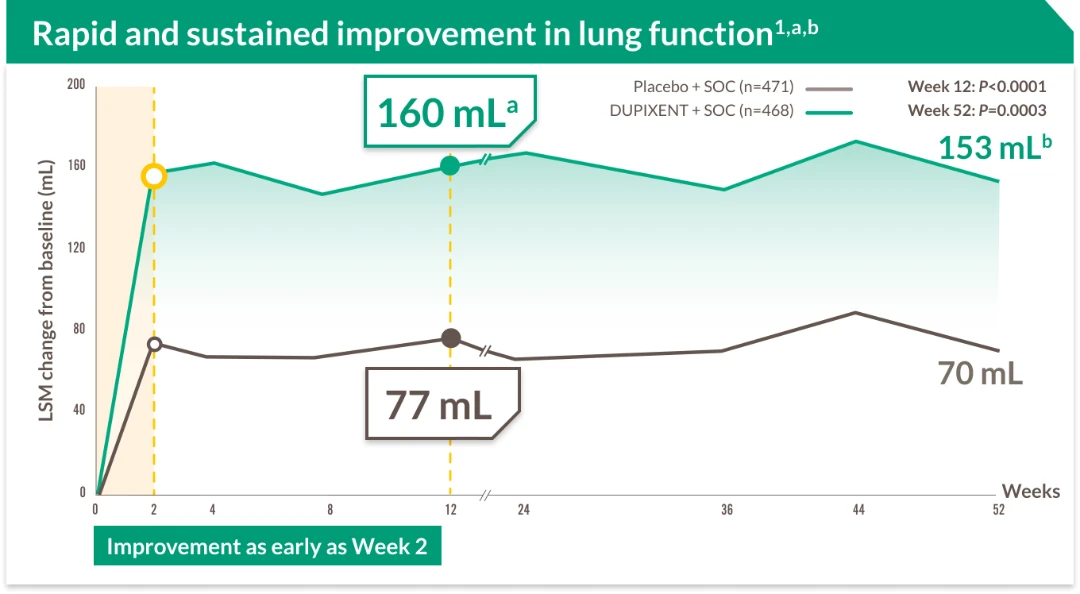
In the NOTUS trial, DUPIXENT+ optimized inhaled theraphy provided an improvement in pre-BD FEV1 from baseline of 139 mL at Week 12 and 115 mL at Week 52 a,b,d,e
NOTUS Trial
Rapid and sustained improvement in lung functiona,b
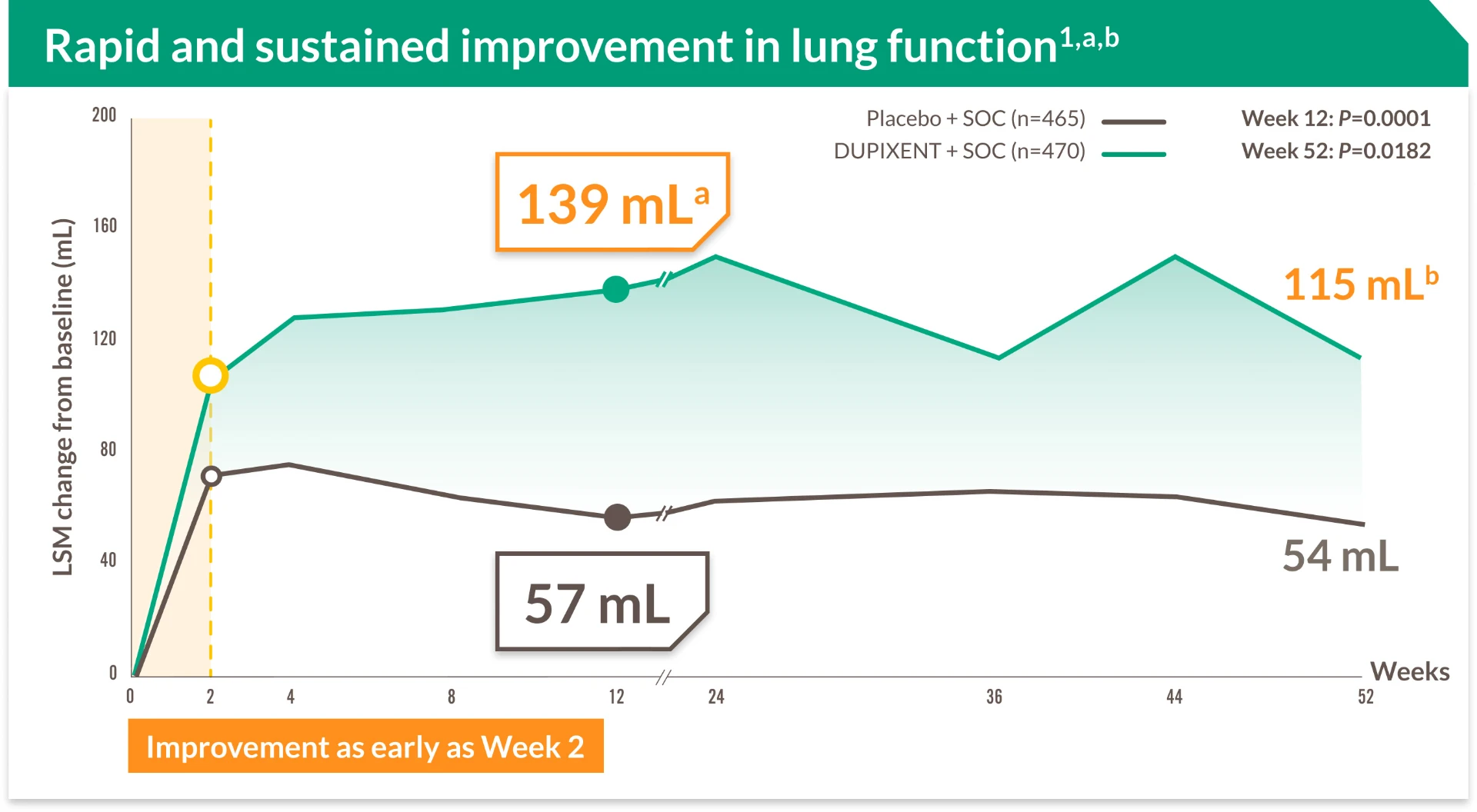
a Key secondary endpoint was the LSM change from baseline in pre-BD FEV1 at Week 12.1
b Key secondary endpoint was the LSM change from baseline in pre-BD FEV1 at Week 52.1
cTriple inhaled theraphy, or double inhaled theraphy if ICS is inappropriate.
dAt Week 12, placebo + SOC improvement: 57 mL (P=0.0001).
eAt Week 52, placebo + SOC improvement: 54 mL (P=0.0182).
BOREAS Trial
Rapid and sustained improvement in lung function1,b

In the NOTUS trial, DUPIXENT+ optimized inhaled theraphy provided an improvement in pre-BD FEV1 from baseline of 139 mL at Week 12 and 115 mL at Week 52 a,b,d,e
NOTUS Trial
Rapid and sustained improvement in lung functiona,b

a Key secondary endpoint was the LSM change from baseline in pre-BD FEV1 at Week 12.1
b Key secondary endpoint was the LSM change from baseline in pre-BD FEV1 at Week 52.1
cTriple inhaled theraphy, or double inhaled theraphy if ICS is inappropriate.
dAt Week 12, placebo + SOC improvement: 57 mL (P=0.0001).
eAt Week 52, placebo + SOC improvement: 54 mL (P=0.0182).
Quality of life

Improved quality of life with DUPIXENT for MORE I CAN moments
DUPIXENTa SIGNIFICANTLY IMPROVED QUALITY OF LIFE FOR MOST COPD PATIENTS1,8
BOREAS Trial
51.5% of patients on DUPIXENTa achieved a clinically meaningful response in SGRQ total score (≥4 points) vs 43% with placebo at Week 52 (P=0.009)b,c
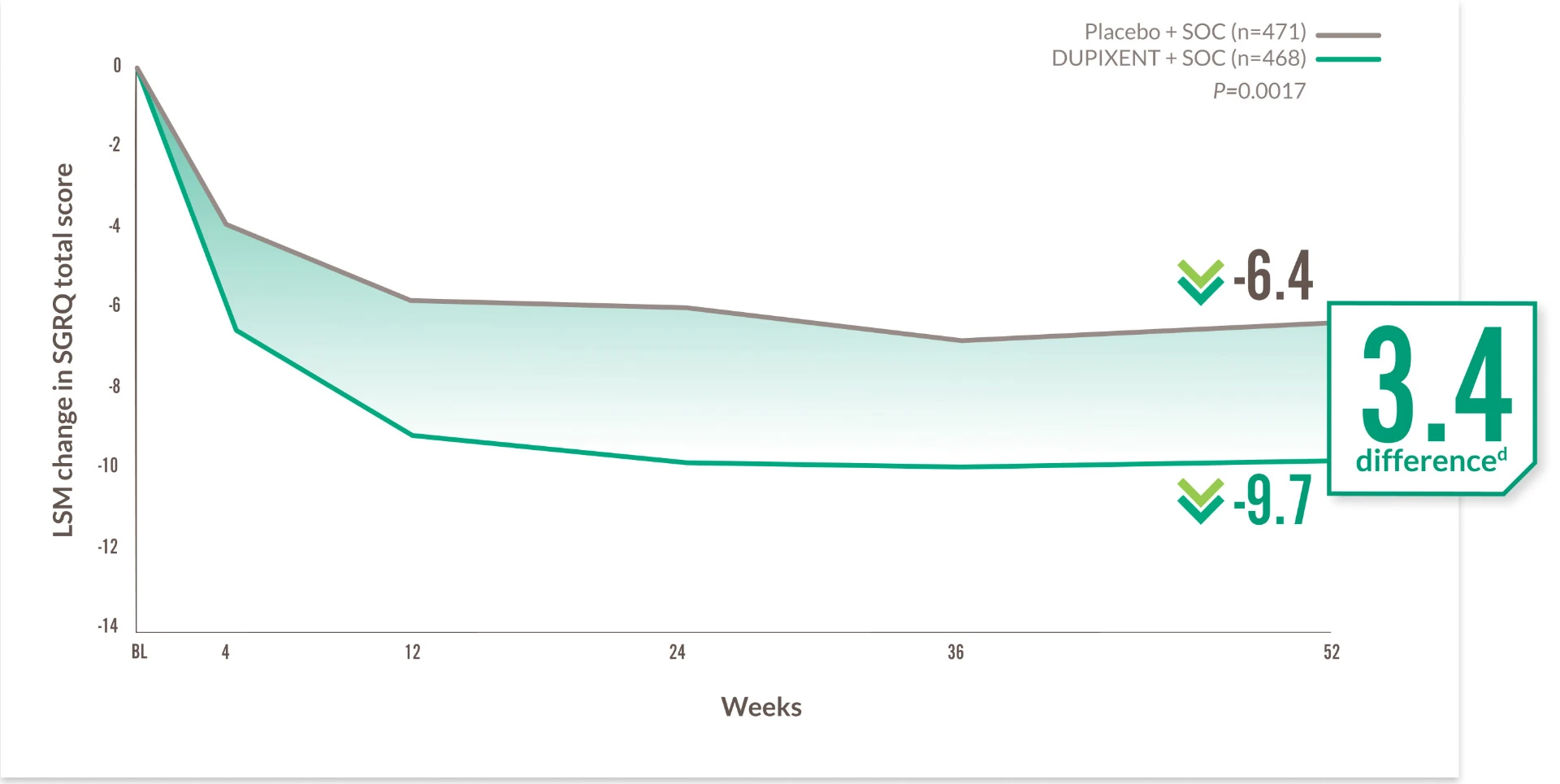
In the NOTUS trial, 51.4% of patients on DUPIXENTa achieved a nominally improved SGRQ total score vs 47% with placebo at Week 52 (OR: 1.16; 95% CI: 0.86, 1.58)b
BOREAS Trial
DUPIXENTa significantly improved quality of life for most COPD patients1,13
Improvement in quality of life (SGRQ)a,b

3.4 differenced |
In the NOTUS trial, patients on DUPIXENTa experienced a nominal LSM difference in SGRQ total score compared with placebo of 3.37 points (95% CI: -5.81, -0.93; P=0.007).1
Select areas of SGRQ measurement11
Cough
Sputum
Breathlessness
Wheezing
Exacerbations
Activities of daily living
Medication
a In addition to triple inhaled therapy, or double inhaled therapy if ICS was not appropriate.1
b Key secondary endpoint was the proportion of patients who achieved a ≥4-point improvement (minimal clinically important difference) in SGRQ total score at Week 52 (BOREAS OR: 1.4; 95% CI: 1.1, 1.9).8,9
c The SGRQ is a 50-item questionnaire designed to measure and quantify health status in adult patients with chronic airflow limitation.8
d LSM difference (BOREAS; Week 52): -3.36 (95% CI: -5.46, -1.27); P=0.0017.1
Symptom Improvement

With DUPIXENT, symptom improvement leads to MORE I CAN moments
DUPIXENT IMPROVED HALLMARK SYMPTOMS THAT IMPACT PATIENT WELL-BEING
BOREAS Trial
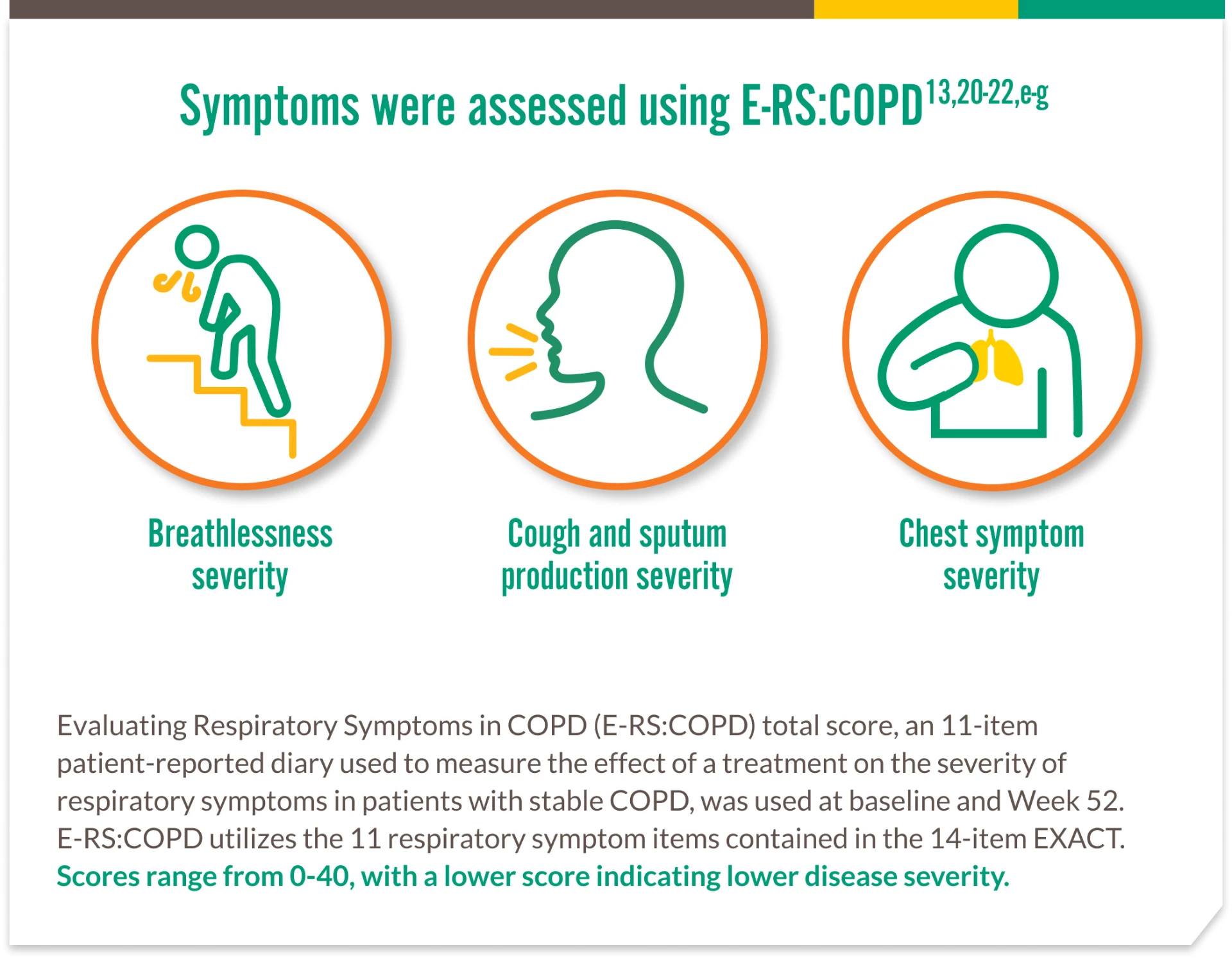
All components of E-RS:COPD score improved
Evaluating Respiratory Symptoms in COPD (E-RS:COPD) total score, an 11-item patient-reported diary used to measure the effect of a treatment on the severity of respiratory symptoms in patients with stable COPD, was used at baseline and Week 52. E-RS:COPD utilizes the 11 respiratory symptom items contained in the 14-item EXACT. Scores range from 0-40, with a lower score indicating lower disease severity.
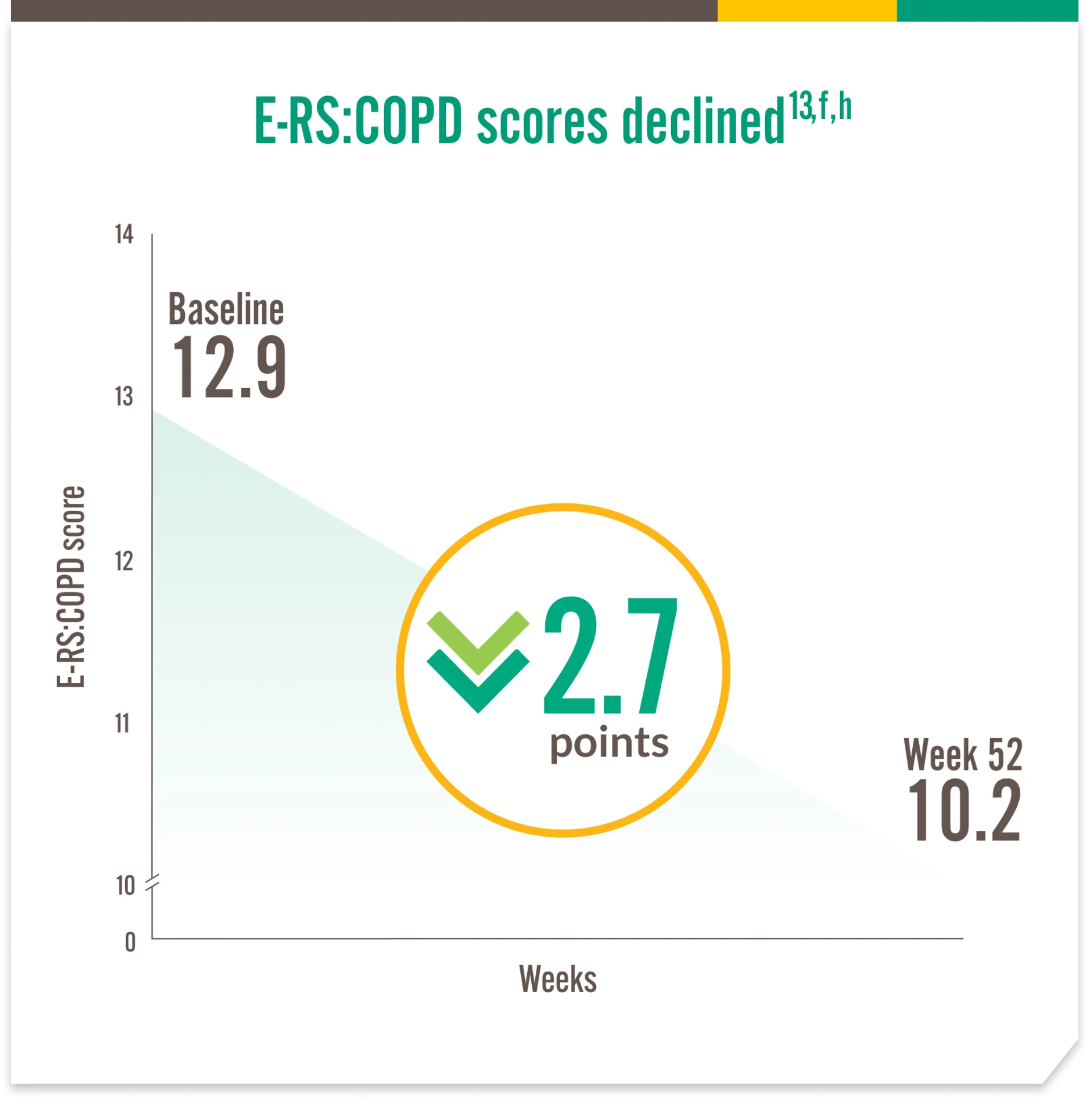
In the NOTUS trial, E-RS:COPD scores declined by 2.4 points.9
E-RS:COPD total clinically meaningful score change threshold is ≥2.0-point reduction.15
a Exploratory endpoint was the change from baseline in E-RS:COPD.8
b DUPIXENT in addition to triple inhaled therapy, or double inhaled therapy if ICS was not appropriate.1
c These are not the only symptoms assessed by E-RS:COPD.14
d E-RS:COPD scores range from 0 to 40, with higher scores indicating greater disease severity.14
Study Design

DUPIXENT enrolled COPD patients with type 2 inflammation across 2 clinical trials
BOREAS AND NOTUS CLINICAL TRIALS
ASSESSED SAFETY, TOLERABILITY, AND EFFICACY IN COPD PATIENTS WITH TYPE 2 INFLAMMATION1,7
All patients received background SOC (ICS+LAMA+LABA, or LAMA+LABA if ICS was not appropriate)1,a
Two phase 3, multicenter, international, double-blind, randomized, placebo-controlled trials in patients with uncontrolled COPD1,8,9
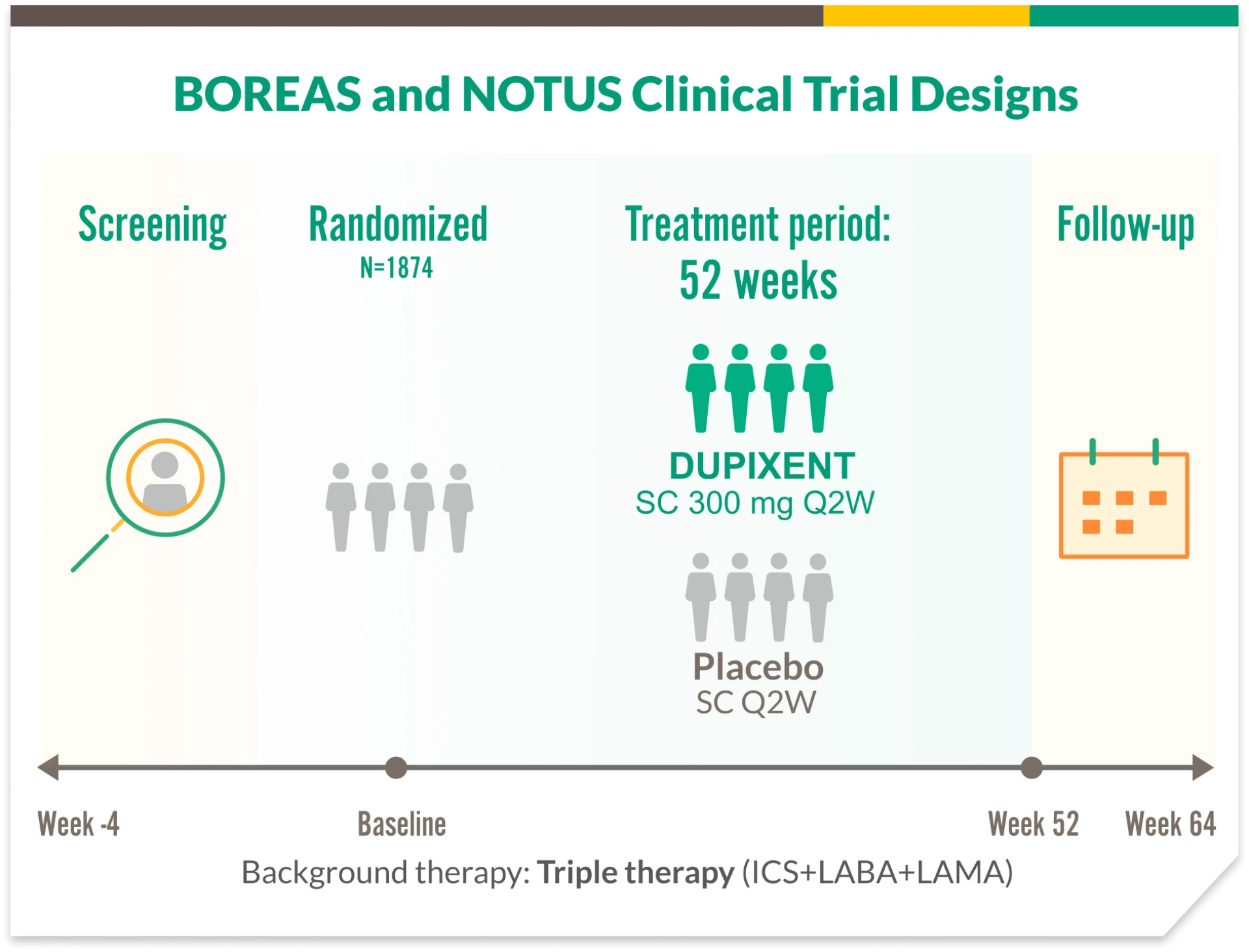
| PRIMARY ENDPOINT | Week 52 | Annualized rate of moderate or severe COPD exacerbations |
| SELECT SECONDARY AND OTHER ENDPOINTS | Week 12 Week 52 | Change in lung function (pre-BD FEV1) from baseline |
| Week 52 | Change in SGRQ total score from baseline | |
| Week 52 | Percentage of patients with SGRQ total score improvement ≥4 points | |
| Week 12 Week 52 | Change in lung function (pre-BD FEV1) from baseline among patients with a baseline FeNO ≥20 ppb | |
| Week 52 | Annualized rate of moderate or severe exacerbations of COPD among patients with a baseline FeNO ≥20 ppb | |
| Week 52 | Change in E-RS:COPD total score from baseline |
a 98% received ICS+LAMA+LABA in BOREAS and 99% in NOTUS.1
|
Key Inclusion Criteria8,9 |
| Physician-diagnosed COPD for ≥12 months prior to randomization |
| Current or former smokers with a smoking history ≥10 pack-years |
| Signs or symptoms of chronic bronchitis (chronic productive cough) for ≥3 months |
| ≥1 exacerbation while the patient was on SOC |
| mMRC dyspnea scale grade ≥2 |
| Blood EOS ≥300 cells/μL |
| ≥2 moderate or ≥1 severe exacerbations within the year prior to screening |
| Background triple therapy (ICS+LAMA+LABA) for 3 months prior to randomization with a stable dose of medication for ≥1 month prior to Visit 1; double therapy (LAMA+LABA) allowed if ICS was not appropriate |
|
Key Exclusion Criteria8,9 |
| Physician-diagnosed COPD for <12 months prior to randomization |
| Diagnosis or history of asthma according to the GINA guidelines |
|
Parameter |
BOREAS (n=939) |
NOTUS (n=935) |
|
Mean age (years) (± SD) |
65.1 (8.1) |
65.0 (8.3) |
|
Male (%) |
66.0 |
67.6 |
|
White (%)b |
84.1 |
89.6 |
|
Mean smoking history (pack-years) (± SD) |
40.5 (23.4) |
40.3 (27.2) |
|
Current smokers (%) |
30 |
29.5 |
| Emphysema (%) |
32.6 |
30.4 |
| Mean duration of COPD (years) (± SD) |
8.8 (6.0) |
9.3 (6.4) |
| Mean number of moderatec or severed exacerbations in previous year (± SD) |
2.3 (1.0) |
2.1 (0.9) |
| Mean number of severe exacerbationsd in previous year (± SD) |
0.3 (0.7) |
0.3 (0.6) |
| Background COPD medications at randomization: ICS/LAMA/LABA (%) |
97.6 |
98.8 |
| Mean postbronchodilator FEV1/FVC ratio (± SD) |
0.5 (0.1) |
0.5 (0.1) |
| Mean prebronchodilator FEV1 (L) (± SD) |
1.3 (0.5) |
1.4 (0.5) |
| Mean postbronchodilator FEV1 (L) (± SD) |
1.4 (0.5) |
1.5 (0.5) |
| Mean percent predicted postbronchodilator FEV1 (%) (± SD) |
50.6 (13.1) |
50.1 (12.6) |
| Mean percent predicted postbronchodilator FEV1 <50% (%) (± SD) |
467 (49.7) |
478 (51.3) |
| Mean SGRQ total score (± SD) |
48.4 (17.4) |
51.5 (17.0) |
| Mean E-RS:COPD [total score] (± SD) |
12.9 (7.1) |
13.3 (7.0) |
| Mean BODE index score (± SD) |
4.1 (1.7) |
4.0 (1.6) |
| Mean FeNO (ppb) (± SD) |
24.3 (22.4) |
24.6 (26.0) |
| Mean baseline blood eosinophil count (cells/μL) (± SD) |
401 (298) |
407 (336) |
| Median baseline blood eosinophil count (cells/μL) (Q1-Q3) |
340 (240-460) |
330 (220-460) |
a Exacerbations treated with either systemic corticostreoids and/or antibiotics.
b Exacerbations requiring hospitalization or observation for over 24 hours in an emergency department or urgent facility.
|
Key Inclusion Criteria8,9 |
| Physician-diagnosed COPD for ≥12 months prior to randomization |
| Current or former smokers with a smoking history ≥10 pack-years |
| Signs or symptoms of chronic bronchitis (chronic productive cough) for ≥3 months |
| ≥1 exacerbation while the patient was on SOC |
| mMRC dyspnea scale grade ≥2 |
| Blood EOS ≥300 cells/μL |
| ≥2 moderate or ≥1 severe exacerbations within the year prior to screening |
| Background triple therapy (ICS+LAMA+LABA) for 3 months prior to randomization with a stable dose of medication for ≥1 month prior to Visit 1; double therapy (LAMA+LABA) allowed if ICS was not appropriate |
|
Key Exclusion Criteria8,9 |
| Physician-diagnosed COPD for <12 months prior to randomization |
| Diagnosis or history of asthma according to the GINA guidelines |
|
Parameter |
BOREAS (n=939) |
NOTUS (n=935) |
|
Mean age (years) (± SD) |
65.1 (8.1) |
65.0 (8.3) |
|
Male (%) |
66.0 |
67.6 |
|
White (%)b |
84.1 |
89.6 |
|
Mean smoking history (pack-years) (± SD) |
40.5 (23.4) |
40.3 (27.2) |
|
Current smokers (%) |
30 |
29.5 |
| Emphysema (%) |
32.6 |
30.4 |
| Mean duration of COPD (years) (± SD) |
8.8 (6.0) |
9.3 (6.4) |
| Mean number of moderatec or severed exacerbations in previous year (± SD) |
2.3 (1.0) |
2.1 (0.9) |
| Mean number of severe exacerbationsd in previous year (± SD) |
0.3 (0.7) |
0.3 (0.6) |
| Background COPD medications at randomization: ICS/LAMA/LABA (%) |
97.6 |
98.8 |
| Mean postbronchodilator FEV1/FVC ratio (± SD) |
0.5 (0.1) |
0.5 (0.1) |
| Mean prebronchodilator FEV1 (L) (± SD) |
1.3 (0.5) |
1.4 (0.5) |
| Mean postbronchodilator FEV1 (L) (± SD) |
1.4 (0.5) |
1.5 (0.5) |
| Mean percent predicted postbronchodilator FEV1 (%) (± SD) |
50.6 (13.1) |
50.1 (12.6) |
| Mean percent predicted postbronchodilator FEV1 <50% (%) (± SD) |
467 (49.7) |
478 (51.3) |
| Mean SGRQ total score (± SD) |
48.4 (17.4) |
51.5 (17.0) |
| Mean E-RS:COPD [total score] (± SD) |
12.9 (7.1) |
13.3 (7.0) |
| Mean BODE index score (± SD) |
4.1 (1.7) |
4.0 (1.6) |
| Mean FeNO (ppb) (± SD) |
24.3 (22.4) |
24.6 (26.0) |
| Mean baseline blood eosinophil count (cells/μL) (± SD) |
401 (298) |
407 (336) |
| Median baseline blood eosinophil count (cells/μL) (Q1-Q3) |
340 (240-460) |
330 (220-460) |
a Exacerbations treated with either systemic corticostreoids and/or antibiotics.
b Exacerbations requiring hospitalization or observation for over 24 hours in an emergency department or urgent facility.
A DEMONSTRATED SAFETY PROFILE ACROSS 6 INDICATIONS1
| System Class | Adverse Reaction | Frequencyd |
| Blood and lymphatic system disorders | Eosinophilia | Common |
| Immune system disorders | Angioedemae Anaphylactic reaction, serum sickness reaction, serum sickness-like reaction | Uncommon Rare |
| Skin and subcutaneous tissue disorders | Facial rashe | Uncommon |
| Musculoskeletal and connective tissue disorders | Arthralgiae | Common |
| General disorders and administration site conditions | Injection site reactions (includes erythema, edema, pruritus, pain, swelling, and bruising) | Common |
| Common adverse events occurring predominantly in atopic dermatitis clinical trials | ||
| Infections and infestations | Conjunctivitis, oral herpes | Common |
| Eye disorders | Conjunctivitis allergic | Common |
| Keratitis,e blepharitis,f eye pruritus,f dry eyef | Uncommon | |
| Ulcerative keratitisee,f | Rare | |
DUPIXENT IS NOT AN IMMUNOSUPPRESSANT AND NOT A STEROID.1 |
|
NOTUS safety8,c |
DUPIXENT (n=469) |
Placebo (n=464) |
|
Any AE |
67% |
66% |
|
Any SAE |
13% |
16% |
|
Any AE leading to death |
3% |
2% |
|
Any AE leading to permanent study intervention discontinuation |
4% |
3% |
|
Major adverse cardiovascular eventb |
1% |
2% |
|
AEs OCCURRING IN ≥5% OF PATIENTS IN EITHER GROUP | ||
| COVID-19 |
9% |
8% |
|
Headache |
8% |
7% |
|
COPD |
5% |
8% |
|
Nasopharyngitis |
6% |
5% |
|
BOREAS safety8,a |
DUPIXENT (n=469) |
Placebo (n=470) |
|
Any AE |
77% |
76% |
|
Any SAE |
14% |
16% |
|
Any AE leading to death |
2% |
2% |
|
Any AE leading to permanent study intervention discontinuation |
3% |
3% |
|
Major adverse cardiovascular eventb |
1% |
2% |
|
AEs OCCURRING IN ≥5% OF PATIENTS IN EITHER GROUP | ||
|
Nasopharyngitis |
9% |
10% |
|
Upper respiratory tract infection |
8% |
10% |
|
Headache |
8% |
7% |
|
COPD |
6% |
6% |
|
COVID-19 |
4% |
6% |
|
Hypertension |
4% |
6% |
|
Diarrhea |
5% |
4% |
|
Back pain |
5% |
3% |
|
NOTUS safety8,c |
DUPIXENT (n=469) |
Placebo (n=464) |
|
Any AE |
67% |
66% |
|
Any SAE |
13% |
16% |
|
Any AE leading to death |
3% |
2% |
|
Any AE leading to permanent study intervention discontinuation |
4% |
3% |
|
Major adverse cardiovascular eventb |
1% |
2% |
|
AEs OCCURRING IN ≥5% OF PATIENTS IN EITHER GROUP | ||
| COVID-19 |
9% |
8% |
|
Headache |
8% |
7% |
|
COPD |
5% |
8% |
|
Nasopharyngitis |
6% |
5% |
|
BOREAS safety8,a |
DUPIXENT (n=469) |
Placebo (n=470) |
|
Any AE |
77% |
76% |
|
Any SAE |
14% |
16% |
|
Any AE leading to death |
2% |
2% |
|
Any AE leading to permanent study intervention discontinuation |
3% |
3% |
|
Major adverse cardiovascular eventb |
1% |
2% |
|
AEs OCCURRING IN ≥5% OF PATIENTS IN EITHER GROUP | ||
|
Nasopharyngitis |
9% |
10% |
|
Upper respiratory tract infection |
8% |
10% |
|
Headache |
8% |
7% |
|
COPD |
6% |
6% |
|
COVID-19 |
4% |
6% |
|
Hypertension |
4% |
6% |
|
Diarrhea |
5% |
4% |
|
Back pain |
5% |
3% |
a Common (≥1/100 to <1/10); uncommon (≥1/1000 to <1/100); rare (≥1/10,000 to <1/1000).
b From postmarketing reporting.1
c The frequencies for eye pruritus, blepharitis, and dry eye were common and ulcerative keratitis was uncommon in atopic dermatitis studies.1
change footnotes/order to this:
d The safety population consisted of all patients who received at least 1 full or partial dose of dupilumab or placebo; the analysis was performed according to the treatment each patient received.
e Major adverse cardiovascular events (adjudicated) included cardiovascular death, nonfatal myocardial infarction, and nonfatal stroke.
f The safety population consisted of all patients who received at least 1 full or partial dose of DUPIXENT or placebo; the analysis was performed according to the treatment each patient received.One patient assigned to the placebo group inadvertently received DUPIXENT, so the safety population includes 470 patients in the placebo group and 469 patients in the DUPIXENT group.
THE FLEXIBILITY OF AT-HOME OR IN-OFFICE ADMINISTRATION
Annualized Rate of moderate or severe COPD exacerbations at Week 52 (primary endpoint)
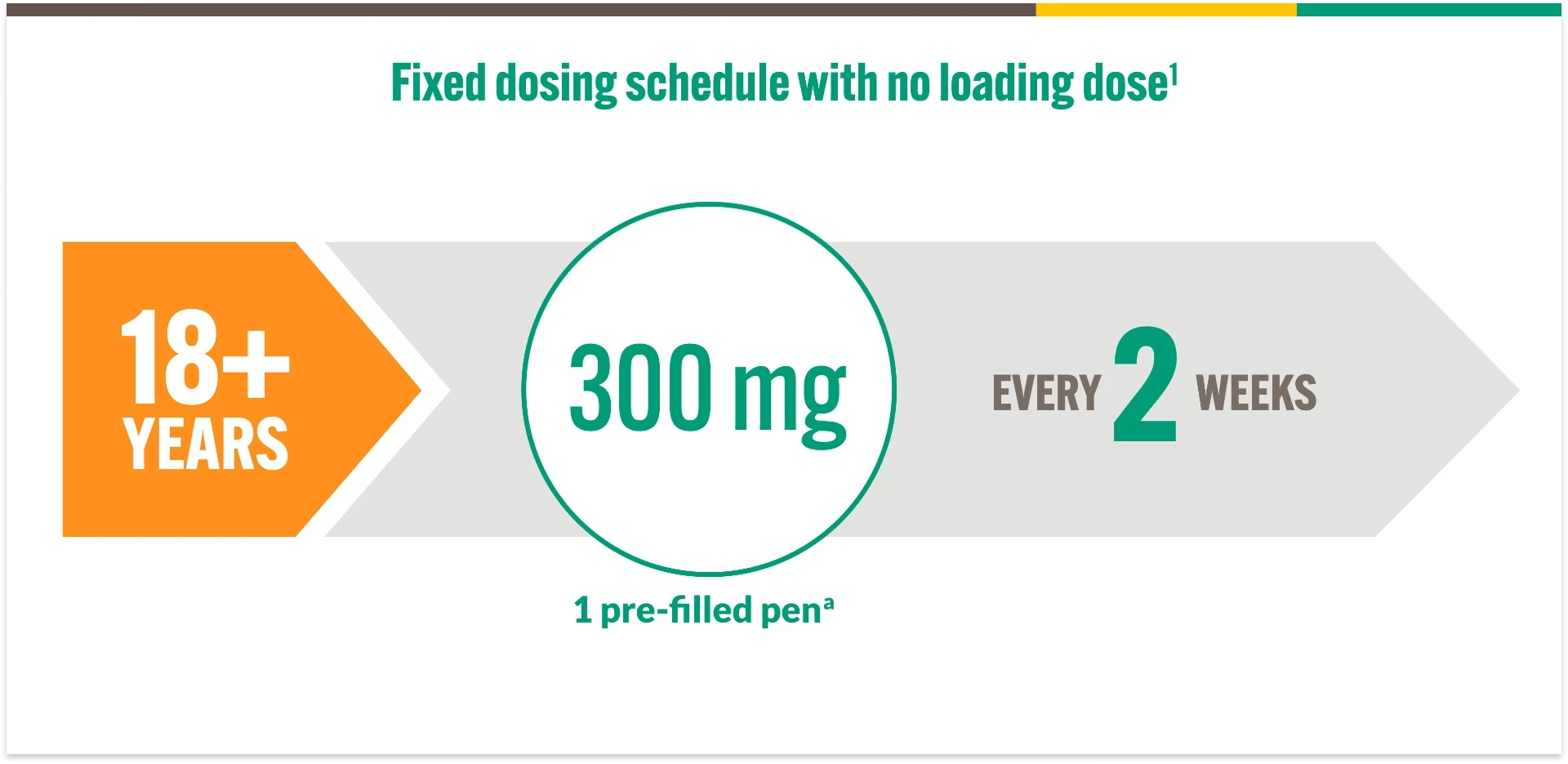
a 300 mg=2 mL solution.1
Two ways to provide confident administration to your patients
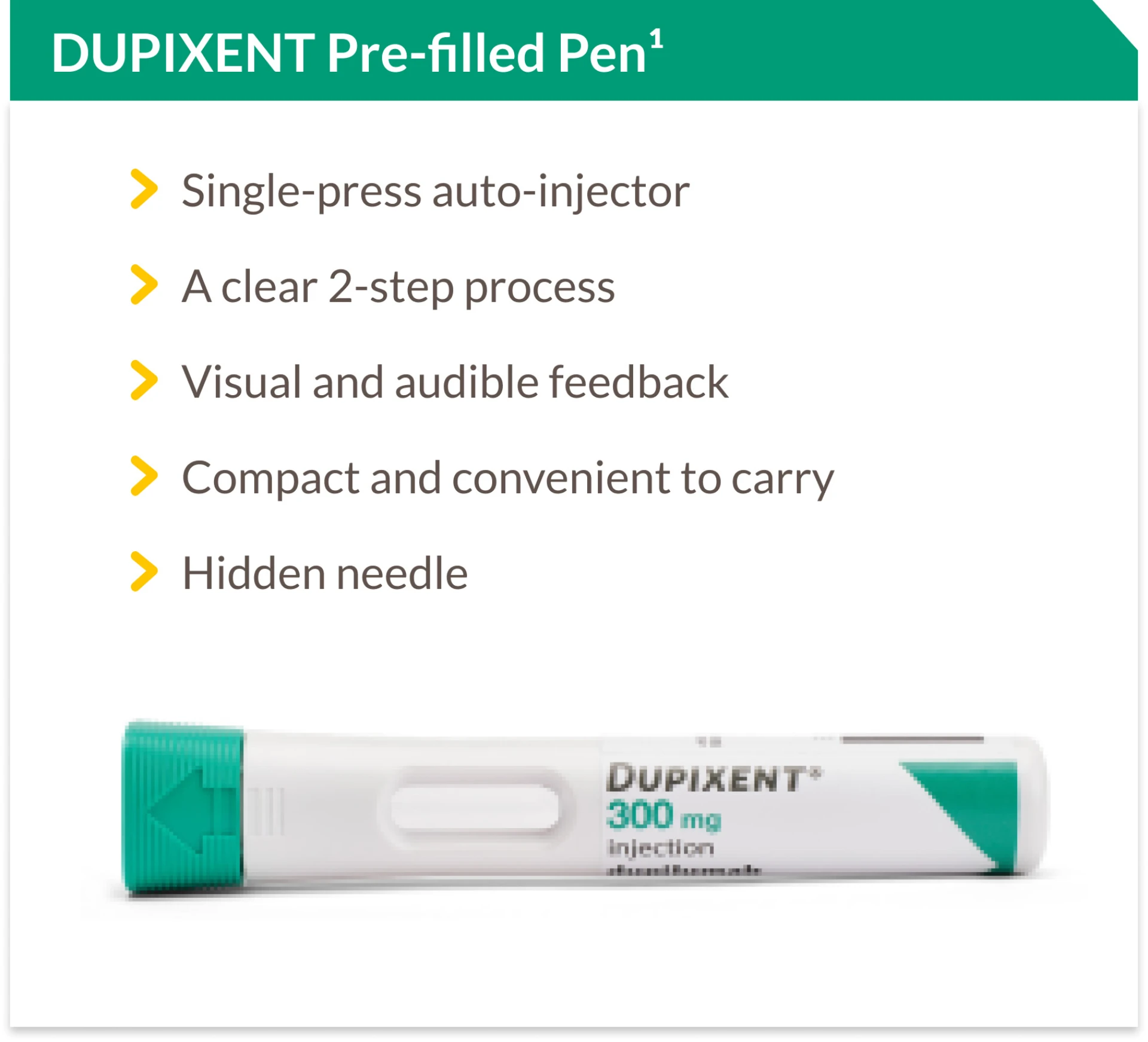
DUPIXENT is intended for use under the guidance of a healthcare provider1
- DUPIXENT can be injected by a patient or caregiver at home after training in a subcutaneous injection technique using the auto-injection pen (for adults and adolescents)
- Physicians or nurses should provide proper training to patients and/or caregivers on the preparation and administration of DUPIXENT prior to use, according to the Instructions for Use
- DUPIXENT can be administered in the office under the guidance of a healthcare provider if the patient or caregiver is not an appropriate candidate to administer the injection
For full administration instructions, please click here for the SmPC.
Annualized Rate of moderate or severe COPD exacerbations at Week 52 (primary endpoint)

a 300 mg=2 mL solution.1
Two ways to provide confident administration to your patients

DUPIXENT is intended for use under the guidance of a healthcare provider1
- DUPIXENT can be injected by a patient or caregiver at home after training in a subcutaneous injection technique using the auto-injection pen (for adults and adolescents)
- Physicians or nurses should provide proper training to patients and/or caregivers on the preparation and administration of DUPIXENT prior to use, according to the Instructions for Use
- DUPIXENT can be administered in the office under the guidance of a healthcare provider if the patient or caregiver is not an appropriate candidate to administer the injection
For full administration instructions, please click here for the SmPC.

7-YEAR LEGACY ACROSS INDICATIONS DRIVEN BY TYPE 2 INFLAMMATION
DUPIXENT has transformed >1,000,000 lives with real-world use in patients as young as 6 months
>1,000,000 patients on therapy worldwide1 |
Atopic dermatitis
uncontrolled severeb
Asthma
severe type 2 asthma or OCS-dependentc
CRS with nasal polyps
severe inadequately controlled
Prurigo nodularis
uncontrolled moderate to severe
Eosinophilic esophagitis
inadequately controlled
COPD
Uncontrolled with type 2 inflammation while on optimized inhaled therapyd
ATOPIC DERMATITIS
DUPIXENT is indicated for the treatment of moderate-to-severe atopic dermatitis in adults and adolescents 12 years and older who are candidates for systemic therapy.
DUPIXENT is indicated for the treatment of severe atopic dermatitis in children 6 years to 11 years old who are candidates for systemic therapy.
ASTHMA
DUPIXENT is indicated in adults and adolescents 12 years and older as add-on maintenance treatment for severe asthma with type 2 inflammation characterized by raised blood eosinophils and/or raised fraction of exhaled nitric oxide (FeNO), who are inadequately controlled with high dose inhaled corticosteroids (ICS) plus another medicinal product for maintenance treatment.
DUPIXENT is indicated in children 6 to 11 years old as add-on maintenance treatment for severe asthma with type 2 inflammation characterised by raised blood eosinophils and/or raised fraction of exhaled nitric oxide (FeNO), who are inadequately controlled with medium to high dose inhaled corticosteroids (ICS) plus another medicinal product for maintenance treatment.
CRS WITH NASAL POLYPS (CRSwNP)
DUPIXENT is indicated as an add-on therapy with intranasal corticosteroids for the treatment of adults with severe CRSwNP for whom therapy with systemic corticosteroids and/or surgery do not provide adequate disease control.
PRURIGO NODULARIS (PN)
DUPIXENT is indicated for the treatment of adults with moderate-to-severe prurigo nodularis who are candidates for systemic therapy.
EOSINOPHILIC ESOPHAGITIS (EoE)
DUPIXENT is indicated for the treatment of eosinophilic esophagitis in adults and adolescents 12 years and older, weighing at least 40 kg, who are inadequately controlled by, are intolerant to, or who are not candidates for conventional medicinal therapy.
CHRONIC OBSTRUCTIVE PULMONARY DISEASE (COPD)
DUPIXENT is indicated in adults as add-on maintenance treatment for uncontrolled chronic obstructive pulmonary disease (COPD) associated with a history of exacerbations and guided by biomarkers of type 2 inflammation (e.g., blood eosinophils).
a From initial FDA approval across patients with atopic dermatitis, asthma, CRS with nasal polyps, prurigo nodularis, EoE, and COPD.
b In patients aged 6 years to 11 years. DUPIXENT is indicated for moderate-to-severe atopic dermatitis in patients aged 12+ years.
c OCS-dependent as specified in GINA guidelines.
d Triple inhaled therapy, or double inhaled therapy if ICS is not appropriate.
AE, adverse event
BD, bronchodilator
BL,baseline
BODE,body mass index, airflow obstruction, dyspnea, and exercise capacity
COPD, chronic obstructive pulmonary disease
CRS, chronic rhinosinusitis
EoE, eosinophilic esophagitis
EOS, eosinophil
E-RS:COPD, Evaluating Respiratory Symptoms in COPD
EXACT, EXAcerbations of COPD Tool
FeNO, fractional exhaled nitric oxide
FEV1, forced expiratory volume in 1 second
FVC, forced vital capacity
GINA, Global Initiative for Asthma
GOLD, Global Initiative for Chronic Obstructive Lung Disease
ICS, inhaled corticosteroid
ICU, intensive care unit
LABA, long-acting beta agonist
LAMA, long-acting muscarinic antagonist
LSM, least squares mean
mMRC, Modified Medical Research Council
OCS, oral corticosteroid
OR, odds ratio
Q2W, once every 2 weeks
SAE, serious adverse event
SC, subcutaneous
SGRQ, St George’s Respiratory Questionnaire
SOC, standard of care
-
DUPIXENT Summary of Product Characteristics, 2024.
-
Garudadri S, Woodruff PG. Targeting chronic obstructive pulmonary disease phenotypes, endotypes, and biomarkers. Ann Am Thorac Soc. 2018;15(suppl 4):S234-S238. doi:10.1513/AnnalsATS.201808-533MG
-
Gandhi NA, Bennett BL, Graham NMH, Pirozzi G, Stahl N, Yancopoulos GD. Targeting key proximal drivers of type 2 inflammation in disease. Nat Rev Drug Discov. 2016;15(1):35-50. doi:10.1038/nrd4624
-
Rabe KF, Rennard S, Martinez FJ, et al. Targeting type 2 inflammation and epithelial alarmins in chronic obstructive pulmonary disease: a biologics outlook. Am J Respir Crit Care Med. 2023;208(4):395-405. doi:10.1164/rccm.202303-0455CI
-
Saatian B, Rezaee F, Desando S, et al. Interleukin-4 and interleukin-13 cause barrier dysfunction in human epithelial cells. Tissue Barriers. 2013;1(2):e24333. doi:10.4161/tisb.24333
-
Cooper PR, Poll CT, Barnes PJ, Sturton RG. Involvement of IL-13 in tobacco smoke–induced changes in the structure and function of rat intrapulmonary airways. Am J Respir Cell Mol Biol. 2010;43(2):220-226. doi:10.1165/rcmb.2009-0117OC
-
Global Initiative for Chronic Obstructive Lung Disease. Global strategy for the diagnosis, management, and prevention of chronic obstructive pulmonary disease (2024 report). Accessed [July 31, 2024]. https://goldcopd.org/2024-gold-report/
-
Bhatt SP, Rabe KF, Hanania NA, et al; BOREAS Investigators. Dupilumab for COPD with type 2 inflammation indicated by eosinophil counts. N Engl J Med. 2023;389(3):205-214. doi:10.1056/NEJMoa2303951
-
Bhatt SP, Rabe KF, Hanania NA, et al; NOTUS Study Investigators. Dupilumab for COPD with blood eosinophil evidence of type 2 inflammation. N Engl J Med. 2024;390(24):2274-2283. doi:10.1056/NEJMoa2401304
-
Suissa S, Dell’Aniello S, Ernst P. Long-term natural history of chronic obstructive pulmonary disease: severe exacerbations and mortality. Thorax. 2012;67(11):957-963. doi:10.1136/thoraxjnl-2011-201518
-
Jones PW. St George’s Respiratory Questionnaire Manual. [Version 2.4, March 2022]. Accessed [July 31, 2024]. https://www.sgul.ac.uk/research/research-operations/research-administration/st-georges-respiratory-questionnaire/docs/SGRQ-Manual-March-2022.pdf
-
EXACT and E-RS:COPD content. Evidera website. Accessed [July 31, 2024]. https://www.evidera.com/what-we-do/patient-centered-research/coa-instrument-management-services/exact-program/exact-content/
-
Data on file, BOREAS CSR, Sanofi.
-
Leidy NK, Bushnell DM, Thach C, Hache C, Gutzwiller FS. Interpreting Evaluating Respiratory Symptoms™ in COPD diary scores in clinical trials: terminology, methods, and recommendations. Chronic Obstr Pulm Dis. 2022;9(4):576-590. doi:10.15326/ jcopdf.2022.0307
-
Bushnell DM, Wilson R, Gutzwiller FS, et al. Use of the Evaluating Respiratory Symptoms™ in COPD as an outcome measure in clinical trials: a rapid systematic review. Chronic Obstr Pulm Dis. 2021;8(4):551-571. doi:10.15326/jcopdf.2021.0235
-
IQVIA Sanofi Integrated DUPIXENT Platform, data through [May 2024].
-
Global Initiative for Asthma. Global strategy for asthma management and prevention. Updated 2024. Accessed [July 31, 2024]. https://ginasthma.org/wp-content/uploads/2024/05/GINA-2024-Strategy-Report-24_05_22_WMS.pdf
Saudi Arabia: The National Pharmacovigilance and Drug Safety Centre (NPC)
SFDA call center: 19999 • E-mail: npc.drug@sfda.gov.sa • Website: https://ade.sfda.gov.sa/
Full Prescribing Information is available upon request: SANOFI, Kingdom of Saudi Arabia, P.O. Box 9874, Jeddah 21423, K.S.A.
Tel: +966-12-669-3318, Fax: +966-12-663-6191
For Medical Information, please contact: +966-12-669-3318, ksa.medicalinformation@sanofi.com
For Pharmacovigilance, please contact: +966-54-428-4797, ksa_pharmacovigilance@sanofi.com
To report any Product Technical Complaint, please contact SANOFI Quality Department:
.png)
